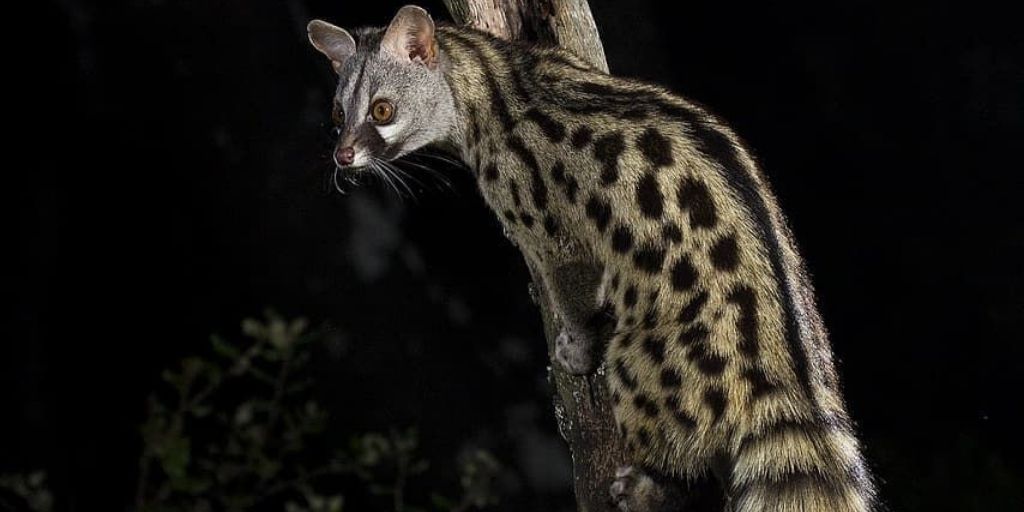Civets are generally small-sized mammals. They look like cats. A civet’s body is long and lean. It is found in tropical forests. The African civet is a well-known civet species. From this species, a musky scent is obtained that is used as perfumes. Civets belong to the order Carnivora and suborder Feliformia.
Our wildlife guide to the civets covers all the details of the animal. Let’s quickly get to the sections below for knowing more about the civets and most importantly about the African civets.

- Latin name: Civettictis civetta
- Family name: Viverridae
- Size: 43-71 centimeters
- Weight:4-4.5 kilograms
Skip to: Characteristics, Range & habitat, Diet, Behaviour, Fun facts, Video
Civet characteristics
Civets are small, lean, and nocturnal mammals. They have a cat-like appearance. Their muzzles are extended and pointed. A civet’s muzzle often looks like that of a mongoose of a ferret. Their height ranges from 43-71 cm. It excludes the length of their tails. They have long tails. Their weight is between 1.4-4.5 kg.
Civets produce a must or aromatic substance. This musk is highly valuable and used as a stabilizing agent for perfume. The musk produced by these animals is called “civet musk”. Civets have a special gland called perineal glands that secretes this musk. Both male and female civets produce this strong-smelling substance.
Range & habitat
Civets are native to tropical forests of Asia and Africa. Most of the civet species are found in southeast Asia. Civets are generally found in the following habitats:
- Woodlands
- Savanna
- Mountain biome
Civets are native to the following regions:
- Sub-Saharan Africa
- Madagascar
- Iberian Peninsula
- Southern China
- South Asia
- Southeast Asia
Let’s know more about some important species of civets. You can read about their range and habitat here.
African civet (Civettictis civetta)
African civets are native to sub-Saharan Africa. You can find these civets in woodlands and secondary forests. This civet has been listed as Least Concern on the IUCN Red List since 2008.
The African civet has rough and wire-like fur. The color of its fur varies from white to creamy yellow to reddish on the back. It has stripes, spots, and blotches of deep brown or black. There is a black band that stretches across its tiny eyes. African civets are primarily nocturnal and they are seen after the sunset.
Malayan civet (Viverra tangalunga)
The Malay civet or the Oriental civet is native to the Malay Peninsula and the islands of Sumatra, Borneo, Philippines, etc.
It lives in a variety of habitats that includes forests, secondary habitats, cultivated lands, and the outskirts of village areas.
Asian palm civet (Paradoxurus hermaphroditus)
Asian palm civets are native to South and Southeast Asia. It is generally 53 cm long and weighs 2-5 kg.
You can find these civets in India, Nepal, Bangladesh, Bhutan, Myanmar, Sri Lanka, China, etc. This civet lives in primary forests, secondary and logged forests. It can also be found in parks and suburban gardens with fruit trees and fig trees. They are good climbers.
Golden palm civet (Paradoxurus zeylonensis)
Golden palm civets are native to only Sri Lanka. It has been listed as Vulnerable on the IUCN Red List.
The golden palm civets are mainly found in the lowland rain forests, evergreen forests in mountains, and dense monsoon forests of Sri Lanka.


Diet
Civets are generally carnivorous animals. However, some of the civet species are omnivores and herbivores. Many civets eat fruit. Sometimes they eat flower nectar as a primary source of energy.
Research in Southeastern Nigeria revealed some interesting facts about the African civet’s diet. Let’s have a look at its omnivorous diet.
An African civet eats,
- Giant pouched rat
- Temminck’s mouse
- Greater cane rat
- Grass mouse
- Toad
- Herald snake
- Black-necked spitting cobra
- Eggs
- Fruits
- Seeds, etc.
The research also shows they eat green grass too.
Behavior & lifestyle
Civets are nocturnal and they spend the day sleeping in dense forests. They wake up after dusk and remain active throughout the night. Civets are generally solitary mammals.
African civets show some unique features. When these civets feel threatened, they raise the dorsal crest to make it look larger. They show this predatory defense to show they are dangerous and formidable to attack.
African civets mate between October to November. They give birth in the rainy season. The average lifespan of the captive African civets is 15-20 years.


Fun civet facts
Here is a list of “Top 5 Fun Civet Facts” that will definitely make you stunned. Civets are really interesting to learn about. Without further delay, let’s quickly get to the list.
- The civets sold for meat in the local markets of the Yunnan Province of China carried the SARS virus to humans. It led to the viral outbreak in 2002-2003 in the area.
- The musky scent (civetone) used in perfumes was obtained from the African civets.
- Kopi luwak is a coffee that is obtained from the dung of Asian palm civets. 0.5 kg of Kopi luwak cost up to $600 and in some other parts of the world, it costs $100 just for a single cup!
- Civets mate for only 40-70 seconds.
- Civets lead a lonely life. They only meet females during mating.
Meet the civet
You can read about The Wild Cats Of Africa here.
Did you enjoy learning more about the civet? Have you ever met this unique creature face-to-face? Tell us about your civet experience in the comments section below. Because those who care share!
References
- Chisholm, Hugh, ed. (1911). “Civet“. Encyclopædia Britannica. 6 (11th ed.). Cambridge University Press. p. 402.
- Lau, Susanna K.P.; et al. (2005). “Severe acute respiratory syndrome coronavirus-like virus in Chinese horseshoe bats”. Proceedings of the National Academy of Sciences. 102 (39): 14040–14145. doi:10.1073/pnas.0506735102. PMC 1236580. PMID 16169905.
- “Summary of probable SARS cases with onset of illness from 1 November 2002 to 31 July 2003“. World Health Organization (WHO). Retrieved 31 October 2008.
- The Straight Dope: Does civet come from tortured cats? Does kopi luwak coffee come from pre-eaten beans?
- Mathai, J. (2010). “Hose’s Civet: Borneo’s mysterious carnivore”. Nature Watch 18/4: 2-8.
- Brewed Coffee: Civet Coffee, 30 November 2006, retrieved 25 May 2009
- Onishi, Norimitsu (17 April 2010). “From Dung to Coffee Brew With No Aftertaste“. The New York Times.
- From Civet Poop to Great Coffee, retrieved 22 July 2010
- Do Linh San, E.; Gaubert, P.; Wondmagegne, D. & Ray, J. (2015). “Civettictis civetta”. IUCN Red List of Threatened Species. 2015: e.T41695A45218199.
- Wozencraft, W.C. (2005). “Civettictis civetta”. In Wilson, D.E.; Reeder, D.M (eds.). Mammal Species of the World: A Taxonomic and Geographic Reference (3rd ed.). Johns Hopkins University Press. p. 554. ISBN 978-0-8018-8221-0. OCLC 62265494.
- Richardson, P. R. K.; Levitan, C. D. (1994). “Tolerance of Aardwolves to Defense Secretions of Trinervitermes trinervoides”. Journal of Mammalogy. 75 (1): 84–91. doi:10.2307/1382238. JSTOR 1382238.
- Kingdon, J. (2015). “African Civet Civettictis civetta”. The Kingdon Field Guide to African Mammals (Second ed.). London, New Delhi, New York, Sydney: Bloomsbury Publishing. pp. 409–410. ISBN 978-1-4729-2531-2.
- Ray, J. C. (1995). “Civettictis civetta” (PDF). Mammalian Species (488): 1–7. doi:10.2307/3504320. JSTOR 3504320. Archived from the original (PDF) on 2013-05-15. Retrieved 2011-09-22.
- Wozencraft, W.C. (2005). “Species Paradoxurus hermaphroditus”. In Wilson, D.E.; Reeder, D.M (eds.). Mammal Species of the World: A Taxonomic and Geographic Reference (3rd ed.). Johns Hopkins University Press. pp. 532–628. ISBN 978-0-8018-8221-0. OCLC 62265494.
- Duckworth, J.W.; Timmins, R.J.; Choudhury, A.; Chutipong, W.; Willcox, D.H.A.; Mudappa, D.; Rahman, H.; Widmann, P.; Wilting, A. & Xu, W. (2016). “Paradoxurus hermaphroditus”. IUCN Red List of Threatened Species. 2016: e.T41693A45217835.
